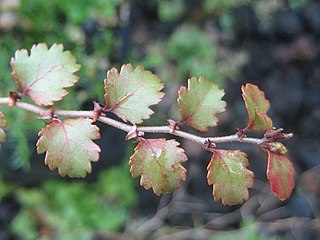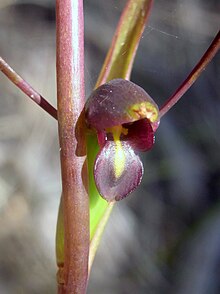
The Antarctic flora is a distinct community of vascular plants which evolved millions of years ago on the supercontinent of Gondwana. It is now found on several separate areas of the Southern Hemisphere, including southern South America, southernmost Africa, New Zealand, Australia and New Caledonia. Joseph Dalton Hooker was the first to notice similarities in the flora and speculated that Antarctica had served as either a source or a transitional point, and that land masses now separated might formerly have been adjacent.

Acianthus, commonly known as mosquito orchids, is a genus of about twelve species of plants in the orchid family, Orchidaceae. Mosquito orchids are terrestrial herbs with a single, heart-shaped, usually ground-hugging leaf and one to many small, green, pinkish or purplish flowers on a fleshy stalk. They are found in New Caledonia, Australia and New Zealand.

Caladenia, commonly known as spider orchids, is a genus of 350 species of plants in the orchid family, Orchidaceae. Spider orchids are terrestrial herbs with a single hairy leaf and a hairy stem. The labellum is fringed or toothed in most species and there are small projections called calli on the labellum. The flowers have adaptations to attract particular species of insects for pollination. The genus is divided into three groups on the basis of flower shape, broadly, spider orchids, zebra orchids and cowslip orchids, although other common names are often used. Although they occur in other countries, most are Australian and 136 species occur in Western Australia, making it the most species-rich orchid genus in that state.

Thelymitra, commonly known as sun orchids, is a genus of more than 100 species of plants in the orchid family, Orchidaceae. Unlike most other orchids, sun orchids lack a highly modified labellum and all three petals are similar in size, shape and colour. The column is, however, highly modified and usually has prominent wings or glands which are helpful in identifying the species. Most sun orchids close their flowers at night, in cloudy or cool weather, giving rise to their common name. The scientific name means "woman's hood" and refers to the hooded column present in most, but not all species. Most species are endemic to Australia although some are found as far from there as the Philippines and Indonesia. The type species, Thelymitra longifolia, the first to be formally described, was collected in New Zealand.

Microtis, commonly known as onion orchids or mignonette orchids is a genus of about 20 species of plants in the orchid family, Orchidaceae. Onion orchids are terrestrial herbs with a single leaf at the base of the plant. They are similar to orchids in the genus Prasophyllum in that they have an onion-like leaf. The flowers are small but often scented and attractive to their insect pollinators. They are widespread in Asia, Australia and some Pacific islands.

Prasophyllum, commonly known as leek orchids, is a genus of about 140 species of flowering plants in the orchid family, Orchidaceae and is found in Australia and New Zealand. The Australian species are found in all states but have not been recorded in the Northern Territory. The common name arises from their having a hollow, leek- or onion-like leaf. Some species only flower after summer fires and have flowers similar to those of Xanthorrhoea which flower at the same time, suggesting that they employ the same pollinating insects. Leek orchids are similar to those in the genus Genoplesium except that the free part of the leaf is cylindrical and the labellum has a solid connection to the column. They range in size from the little laughing leek orchid at about 15 cm (6 in) to the king leek orchid which grows up to 2 m (80 in) tall.

Corybas, commonly known as helmet orchids, is a genus of about 120 species of plants in the orchid family, Orchidaceae. Helmet orchids are small, perennial, deciduous herbs and are nearly always terrestrial. They have a single leaf at their base and a single flower on a short stalk, the flower dominated by its large dorsal sepal and labellum. Species of Corybas are found in Australia, New Zealand, New Guinea, Southeast Asia, the Himalayas, southern China, many Pacific islands and a few sub-Antarctic islands.

Calochilus, commonly known as beard orchids, is a genus of about 30 species of plants in the orchid family, Orchidaceae. Beard orchids are terrestrial herbs with a single leaf at the base of the plant, or no leaves. Their most striking feature is a densely hairy labellum, giving rise to their common name. Beard orchids, unlike some other Australian orchids, do not reproduce using daughter tubers, but self-pollinate when cross-pollination has not occurred. Most species occur in Australia but some are found in New Zealand, New Guinea and New Caledonia.

Chrysoglossum is a genus of flowering plants from the orchid family, Orchidaceae. Its 4 species are native to China, the Indian Subcontinent, southeast Asia, New Guinea and some islands of the western Pacific.
- Chrysoglossum assamicumHook.f.. - Guangxi, Tibet, Assam, Thailand, Vietnam
- Chrysoglossum ensigerumW.Burgh & de Vogel - Sumatra
- Chrysoglossum ornatumBlume - India, Nepal, Assam, Bhutan, Sri Lanka, Cambodia, Thailand, Vietnam, Malaysia, Java, Borneo, Sulawesi, Sumatra, Philippines, New Guinea, Fiji, New Caledonia, Samoa, Vanuatu, China
- Chrysoglossum reticulatumCarr - Sabah, Sarawak
Clematepistephium is a genus of flowering plants from the orchid family, Orchidaceae. It contains only one known species, Clematepistephium smilacifolium, endemic to the island of New Caledonia. Its closest relative is Eriaxis, also endemic to New Caledonia.

Cryptostylis, commonly known as tongue orchids, is a genus of flowering plants from the orchid family. Tongue orchids are terrestrial herbs with one to a few stalked leaves at the base of the flowering stem, or leafless. One to a few dull coloured flowers are borne on an erect flowering stem. The most conspicuous part of the flower is the labellum, compared to the much reduced sepals and petals. At least some species are pollinated by wasps when they attempt to mate with the flower. There are about twenty five species found in South Asia, Southeast Asia and the South Pacific.

Drymoanthus, commonly known as midget orchids is a genus of epiphytic orchids in the family Orchidaceae. Plants in this genus are relatively small and unbranched with thick roots, narrow crowded leaves and small scented green flowers with a white labellum. There are four species, found in Australia, New Zealand and New Caledonia.

Genoplesium commonly known as midge orchids, is a genus of about 50 species of flowering plants in the orchid family, Orchidaceae and is found in Australia, New Zealand and New Caledonia. Midge orchids are terrestrial herbs with a single leaf at the base of the plant. They are similar to orchids in the genus Prasophyllum in that plants without flowers have a hollow, onion-like leaf. The flowers are small but often scented and attractive to their insect pollinators. There is disagreement about which species belong to this genus and some taxonomists suggest that most belong in the genus Corunastylis.

Geodorum, commonly known as shepherds' crooks or 地宝兰属 , is a genus of eight species of flowering plants in the orchid family, Orchidaceae. They are deciduous, terrestrial herbs with underground pseudobulbs, broad, pleated leaves and small to medium-sized, tube-shaped or bell-shaped flowers on a flowering stem with a drooping end. Species in this genus are found in southern Japan, tropical Asia, Australia and islands of the southwest Pacific Ocean.
Hymenorchis is a genus of flowering plants from the orchid family, Orchidaceae. It is native to Malaysia, Indonesia, Philippines, New Guinea and New Caledonia.
- Hymenorchis brassiiOrmerod - Papua New Guinea
- Hymenorchis caulinaSchltr. - New Guinea
- Hymenorchis foliosaSchltr. - New Guinea
- Hymenorchis glomeroidesJ.J.Sm. - New Guinea
- Hymenorchis javanica(Teijsm. & Binn.) Schltr. - Pahang, Java
- Hymenorchis kaniensisSchltr. - New Guinea
- Hymenorchis nannodesSchltr. - New Guinea
- Hymenorchis saccataSchltr. - New Guinea
- Hymenorchis serrataSchltr. - New Guinea
- Hymenorchis serrulata(N.Hallé) Garay - New Caledonia
- Hymenorchis taniiSchuit. & de Vogel - Papua New Guinea
- Hymenorchis vanoverberghii(Ames) Garay - Philippines

Lyperanthus, commonly known as beak orchids, is a genus of flowering plants from the orchid family, Orchidaceae, that is endemic to Australia. There are two species, one in Western Australia and the other in four eastern Australian states, distinguished by their single long, narrow, leathery leaf and dull coloured flowers which have prominent short calli on their labellum. Both form loose colonies which reproduce asexually from their tubers, and sexually using their flowers.
Pachyplectron is a genus of flowering plants from the orchid family, Orchidaceae. The genus contains three species, all endemic to New Caledonia. The genus is related to Odontochilus.
Sarcanthopsis, commonly known as goliath orchids, is a genus of six species of flowering plants from the orchid family, Orchidaceae. Plants in this genus are large epiphytes or lithophytes with long, thick, leathery stems, large, crowded leathery leaves and many yellowish flowers on a branched flowering stem. Orchids in this genus occur in New Guinea and islands of the south-west Pacific.

Orthoceras strictum, commonly known as the bird's-mouth orchid or horned orchid, is a species of orchid native to eastern and southern Australia, New Zealand and New Caledonia. It has between two and five linear leaves and up to nine yellowish green, brownish or blackish flowers with two long, erect to spreading lateral sepals.

Orthoceras novae-zeelandiae, commonly known as the New Zealand horned orchid, is a species of orchid native to New Zealand.
















